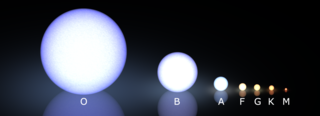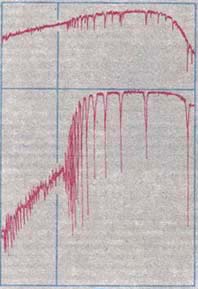Related Research Articles

In astronomy, stellar classification is the classification of stars based on their spectral characteristics. Electromagnetic radiation from the star is analyzed by splitting it with a prism or diffraction grating into a spectrum exhibiting the rainbow of colors interspersed with spectral lines. Each line indicates a particular chemical element or molecule, with the line strength indicating the abundance of that element. The strengths of the different spectral lines vary mainly due to the temperature of the photosphere, although in some cases there are true abundance differences. The spectral class of a star is a short code primarily summarizing the ionization state, giving an objective measure of the photosphere's temperature.

Wolf–Rayet stars, often abbreviated as WR stars, are a rare heterogeneous set of stars with unusual spectra showing prominent broad emission lines of ionised helium and highly ionised nitrogen or carbon. The spectra indicate very high surface enhancement of heavy elements, depletion of hydrogen, and strong stellar winds. Their surface temperatures range from 30,000 K to around 210,000 K, hotter than almost all other stars. They were previously called W-type stars referring to their spectral classification.
Astrophysics is a science that employs the methods and principles of physics in the study of astronomical objects and phenomena. Among the subjects studied are the Sun, other stars, galaxies, extrasolar planets, the interstellar medium and the cosmic microwave background. Emissions from these objects are examined across all parts of the electromagnetic spectrum, and the properties examined include luminosity, density, temperature, and chemical composition. Because astrophysics is a very broad subject, astrophysicists apply concepts and methods from many disciplines of physics, including classical mechanics, electromagnetism, statistical mechanics, thermodynamics, quantum mechanics, relativity, nuclear and particle physics, and atomic and molecular physics.

In astronomy, metallicity is the abundance of elements present in an object that are heavier than hydrogen or helium. Most of the normal physical matter in the Universe is either hydrogen and helium, and astronomers use the word "metals" as a convenient short term for "all elements except hydrogen and helium". This usage is distinct from the usual physical definition of a solid metal. Stars and nebulae with relatively high abundances of carbon, nitrogen, oxygen, and neon are called "metal-rich" in astrophysical terms, even though those elements are non-metals in chemistry.
In astrophysics, chemically peculiar stars are stars with distinctly unusual metal abundances, at least in their surface layers.

A subgiant is a star that is brighter than a normal main-sequence star of the same spectral class, but not as bright as giant stars. The term subgiant is applied both to a particular spectral luminosity class and to a stage in the evolution of a star.
41 Andromedae is a single star in the northern constellation of Andromeda. 41 Andromedae is the Flamsteed designation. It is bright enough to be faintly visible to the naked eye, having an apparent visual magnitude of 5.04. Based upon an annual parallax shift of 18.4 mas, it is located 178 light years away. The star is moving further from the Earth with a heliocentric radial velocity of +10 km/s and it has a relatively high rate of proper motion, traversing the celestial sphere at the rate of 0.171″ per year.

IK Pegasi is a binary star system in the constellation Pegasus. It is just luminous enough to be seen with the unaided eye, at a distance of about 154 light years from the Solar System.
Microturbulence is a form of turbulence that varies over small distance scales.
In astronomy, color–color diagrams are a means of comparing the apparent magnitudes of stars at different wavelengths. Astronomers typically observe at narrow bands around certain wavelengths, and objects observed will have different brightnesses in each band. The difference in brightness between two bands is referred to as color. On color–color diagrams, the color defined by two wavelength bands is plotted on the horizontal axis, and then the color defined by another brightness difference will be plotted on the vertical axis.
An Am star or metallic-line star is a type of chemically peculiar star of spectral type A whose spectrum has strong and often variable absorption lines of metals such as zinc, strontium, zirconium, and barium, and deficiencies of others, such as calcium and scandium. The original definition of an Am star was one in which the star shows "an apparent surface underabundance of Ca and/or an apparent overabundance of the Fe group and heavier elements".

The Hertzsprung–Russell diagram, abbreviated as H–R diagram, HR diagram or HRD, is a scatter plot of stars showing the relationship between the stars' absolute magnitudes or luminosities versus their stellar classifications or effective temperatures. The diagram was created independently in around 1910 by Ejnar Hertzsprung and Henry Norris Russell, and represented a major step towards an understanding of stellar evolution.

A Pea galaxy, also referred to as a Pea or Green Pea, might be a type of luminous blue compact galaxy that is undergoing very high rates of star formation. Pea galaxies are so-named because of their small size and greenish appearance in the images taken by the Sloan Digital Sky Survey (SDSS).

HD 5980 is a multiple star system on the outskirts of NGC 346 in the Small Magellanic Cloud (SMC) and is one of the brightest stars in the SMC.

AB7, also known as SMC WR7, is a binary star in the Small Magellanic Cloud. A Wolf–Rayet star and a supergiant companion of spectral type O orbit in a period of 19.56 days. The system is surrounded by a ring-shaped nebula known as a bubble nebula.
WR 148 is a spectroscopic binary in the constellation Cygnus. The primary star is a Wolf-Rayet star and one of the most luminous stars known. The secondary has been suspected of being a stellar-mass black hole but may be a class O main sequence star.
15 Ursae Majoris is a star in the northern circumpolar constellation Ursa Major, located 94 light years away from the Sun. It has the Bayer designation f Ursae Majoris; 15 Ursae Majoris is the Flamsteed designation. It is visible to the naked eye as a white-hued star with an apparent visual magnitude of 4.46. 15 Ursae Majoris is a suspected member of the Castor stellar kinematic group, a 200 million year old association of co-moving stars.

An O-type star is a hot, blue-white star of spectral type O in the Yerkes classification system employed by astronomers. They have temperatures in excess of 30,000 kelvin (K). Stars of this type have strong absorption lines of ionised helium, strong lines of other ionised elements, and hydrogen and neutral helium lines weaker than spectral type B.
Stellar molecules are molecules that exist or form in stars. Such formations can take place when the temperature is low enough for molecules to form – typically around 6000 K or cooler. Otherwise the stellar matter is restricted to atoms in the forms of gas or – at very high temperatures – plasma.

The Balmer jump or Balmer discontinuity is the difference of intensity of the stellar continuum spectrum on both sides of the limit of the Balmer series of hydrogen at 364.6 nm. It is caused by electrons being completely ionized directly from the second energy level of a hydrogen atom, which creates a continuum absorption at wavelengths shorter than 364.6 nm.
References
- ↑ Milne, E. A. (1928). "The total absorption in the Sun's reversing layer". The Observatory. 51: 88–96. Bibcode:1928Obs....51...88M.
- ↑ Sandage, Allan R.; Eggen, Olin J. (1959). "On the existence of subdwarfs in the (Mbol, log Te)-diagram". Monthly Notices of the Royal Astronomical Society . 119 (3): 278–296. Bibcode:1959MNRAS.119..278S. doi: 10.1093/mnras/119.3.278 .
- ↑ Straižys, Vytautas (1992). Multicolor Stellar Photometry. Tucson: Pachart Publishing House.